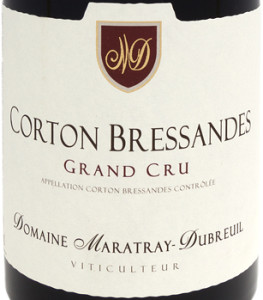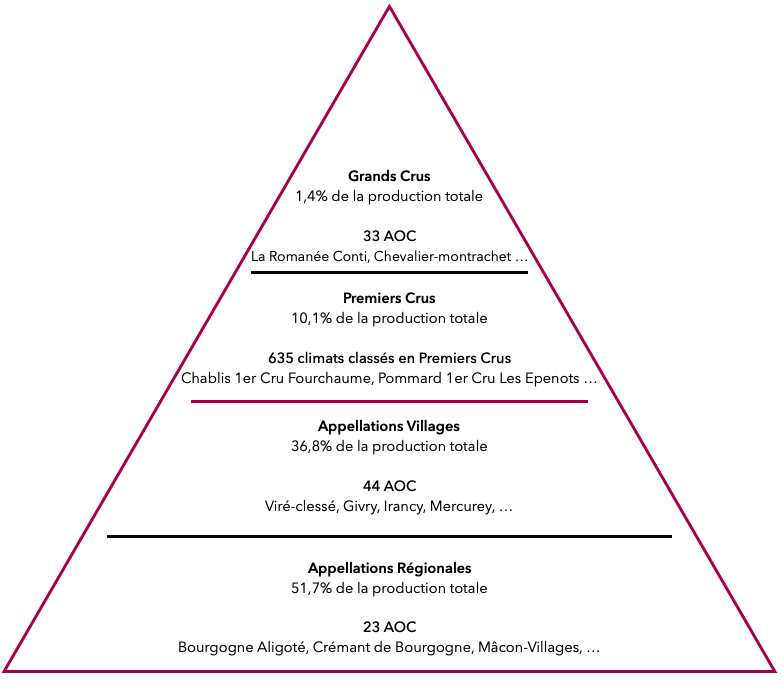Burgundy appellations
It was in 1861 that it all began …
Good news it was at this time that the Agriculture Committee of the district of Beaune drew up a plan of the vineyards producing the great wines, classified separately by commune. But unfortunately it was not until 1930 that the courts complied with these indications. This classification highlights the different crus of Burgundy:
- the first growths for their bouquet, their finesse and their conservation time
- the second vintages include vines less favored by soil, exposure, slope and altitude
- the third cuvées refer to the vines that are placed at the extreme limit of good climates, which makes it possible to appreciate delicate wines with a beautiful ability to age
=> Vines producing the Gamay grape variety and other ordinary grape varieties were not classified.
Today this classification is updated and we note that some current Grands Crus were considered as second or third cuvée in 1861…
This hierarchy is based on the notion of origin, the importance of the terroir and the quality of the wine.
The great diversity of the natural conditions of Burgundy allows a wide variety of appellations, each with its own character and unique personality. This is the true richness of this wine region.
Burgundy appellations
The term "appellation" appeared in the 1930s … from this follows the establishment of the "pyramid of appellations", still in force today. At the time, it allowed:
- firstly to fight against counterfeits * (with the aim of recognising and protecting Burgundy wine products)
- secondly, to organise the wine trade
* The law of 1 August 1905 came to punish "deceptions or attempted deceptions on the nature, quality, species, origin and denomination of goods".
It was on July 30, 1935 that the National Institute of Appellations of Origin (INAO) was created.
Here is what the INAO claims:
-> at national level " an appellation of origin is the name of a country, region or locality used to designate a product originating therein and whose quality or characteristics are due to the geographical environment, including natural and human factors".
-> once the AOC in France has been assigned, there is an application for registration at European level as a PDO (Protected Designation of Origin), which allows them protection throughout the European Union.
Its role is to delimit the different production areas that have the right to the appellation and determine their production conditions (developed just below).
For each appellation are described:
- the category (regional appellation, communal appellation or grand cru appellation)
- production villages
- the list of climates classified as Premier Cru
- the colour and grape variety(ies)
- the area in production
- the minimum alcoholic strength ( this corresponds to the sugar density of the natural grapes expressed as a percentage)
- the maximum alcoholic strength (this corresponds to the density of volumes after chaptalization of the must* expressed as a percentage)
- the cultivation process
- the maximum yield per hectare
- the average annual harvest
- the character of the wines ( wines with a controlled designation of origin have visual, olfactory and taste qualities specific to each, they are established by the Bureau Interprofessionnel des Vins de Bourgogne with the assistance of the wine associations of the appellations concerned)
*the chaptalization of the must corresponds to the addition of sugar, the objective being to increase the degree of alcohol of the wine
Let's talk about the Great Burgundian Pyramid
In Burgundy there are 100 protected designations of origin divided into 4 levels:
I invite you to discover this video that will allow you to understand more simply the classification of these appellations:
Do you like vins de #Bourgogne, but have trouble finding yourself in this constellation of appellations? However, it is not complicated, we assure you! The proof, this video explains in 2min how the #VinsBourgogne are classified! 👉 https://t.co/ZWLxb1r7HT pic.twitter.com/F18tBSHFLG
— Burgundy wines (@VinsdeBourgogne) March 15, 2019
| The Grands Crus of Burgundy are at the top of the hierarchy since they have the best exposures, the most favorable microclimates and terroirs delimited with extreme precision. They are big names known internationally. |
The quality level and consistency of the characteristics of these wines make it possible to distinguish them from other appellations. Some have enjoyed a high reputation for an eternity!
These Grands Crus of Controlled Designation of Origin are designated by the sole name of the climate such as:
-
Bâtard-Montrachet (white)
-
Bienvenues-Bâtard-Montrachet (white)
-
Bonnes-Mares (red)
-
Chablis Grand Cru (white)
-
Chambertin (red)
-
Chambertin-Clos de Bèze (red)
-
Chambertin Chapel (red)
-
Charlemagne (white)
-
Charmes-Chambertin (red)
-
Chevalier-Montrachet (white)
-
Clos des Lambrays (red)
-
Clos de la Roche (red)
-
Clos Saint-Denis (red)
-
Clos de Tart (red)
-
Clos de Vougeot (red)
-
Corton (white and red)
-
Corton-Charlemagne (white)
-
Criots-Bâtard-Montrachet (white)
-
Ladders (red)
-
Large Ladders (red)
-
Griotte-Chambertin (red)
-
The Grande Rue (red)
-
The Task (red)
-
Latricières-Chambertin (red)
-
Montrachet (white)
-
Musigny (white and red)
-
Richebourg (red)
-
(The) Romanée (red)
-
Romanée-Conti (red)
-
Romanée-Saint-Vincent (red)
-
Ruchottes-Chambertin (red)
Many Burgundy vineyards offer premier crus but very few claim one or more of the 33 Grands Cru appellations. It's a great privilege to be a part of it!
✖ Be careful not to confuse the name of the grand cru with the name of the village, here are some examples:
CHAMBERTIN (grand cru) => Gevrey-Chambertin (wine village) MUSIGNY (grand cru) => Chambolle-Musigny (wine village) CORTON (grand cru) => Aloxe-Corton (wine village) MONTRACHET (grand cru) => Puligny-Montrachet or Chassagne-Montrachet (wine villages) 
On the label, the mention Grand Cru must be written immediately below the name of the appellation whose dimensions of the characters are at most equal to two-thirds of those of the characters used for the name of the appellation.
=> An exception for Chablis Grand Cru, it has only one and the same appellation but it has 7 climates that are classified as grand cru. Therefore, the name of the climate must be preceded by the name of the appellation.
Here is the list of these 7 climates:

-
Blanchot
-
Bougros
-
The Clos
-
Frogs
-
The Preuses
-
Valmur
-
Vaudésir
•
| The first growths of Burgundy are below the grands crus but they remain great wines as well. Each bottle is followed by the name of the plot. |
The majority of municipalities have several very varied premiers crus .
On the label, the names of the premiers crus can be written in several ways:
- or placed after the communal designation and in characters whose dimensions (both in height and width) must not exceed those of the appellation
- either printed as before with, in addition, the mention : Premier Cru
- or replaced by the only mention : Premier Cru. In this case, this usually means that the wine comes from the blending of several premiers crus of the same appellation.
•
| The village or communal appellations of Burgundy correspond to the name of the village where the plot is located. |
Here are some examples classified by vineyard:
- Chablis, Petit Chablis, Irancy, Saint Bris in the vineyards of Chablis and Grand Auxerrois
- Marsannay, Morey-Saint-Denis, Nuits-Saint-Georges in the vineyards of the Côte de Nuits and Hautes-Côtes de Nuits
- Pernand-Vergelesses, Beaune, Meursault in the vineyards of the Côte de Beaune and Hautes-Côtes de Beaune
- Bouzeron, Rully, Mercurey, Givry, Montagny in the vineyards of Côte Chalonnaise and Couchois
- Saint-Véran, Pouilly-Fuissé, Pouilly-Vinzelles, Pouilly-Loché in the vineyards of the Mâconnais
•
| The regional appellations of Burgundy are positioned at the bottom of the pyramid, they are produced on all or part of the wine territory of the region. Its production area is the widest and its harvest is the largest. |
There are several regional appellations with different characteristics, such as:
- the grape variety (Bourgogne Aligoté : aligoté grape variety, Bourgogne Passe-Tout-Grains : Pinot Noir and Gamay grape varieties)
- the method of elaboration (Crémant de Bourgogne : traditional method)
- the production region (Mâcon : Mâconnais, Burgundy Hautes-Côtes de Beaune : Arrière-Côte de Beaune, Burgundy Côtes d'Auxerre : Auxerrois)
- the commune of production (in auxerrois: Bourgogne Chitry, Bourgogne Epineuil)
- the locality or the climate of production (in the department of Côte d'Or, Bourgogne Le Chapitre : commune of Chenôve and in the department of Yonne, Bourgogne Côte Saint-Jacques : commune of Joigny)
Note: Grands Crus, Premiers Crus and Communale appellations are produced in a village while regional appellations are produced in all or part of the region.
This pyramidal organization is the same within the six wine regions in Burgundy :
-
Chablis and the great Auxerrois
-
The Côte de Nuits
-
The Côte de Beaune
-
The Chalonnaise Coast
-
The Mâconnais
-
The Châtillonnais
Each appellation is defined by strict specifications validated by decree, the higher one rises in the classification the more demanding the specifications . The controls are meticulous and constant.
What are these criteria?
A few examples:
- geographical delimitation (the more prestigious the appellation, the more restricted its lands)
- soil composition
- size
- altitude
- the exhibition
- alcoholic strength by volume (the higher the quality of the wine, the higher its alcoholic strength)
- the yield (it is expressed in hectolitre per hectare, the higher the wine in the classification the lower this figure)
- grape varieties (only those listed on the specifications are allowed)
- production conditions
- spacing between vines
✖ Not to mention the work of man which is essential to the development of the vine, winemakers only produce great wines if they are up to the task!
Several factors favor the quality of these bottles, such as:
- livestock
- soil balance
- the terroir (all the vineyards of Burgundy are located on hillsides with varied orientations, limestone nature)
- yield management
- the quality of the plant material
Let's talk about localities and "climates" in Burgundy
Each appellation is delimited according to its locality and its "climate" in Burgundy.
=> The locality is the official administrative subdivision identifiable on the cadastre, it indicates a piece of land in Burgundy, its name recalls a peculiarity of topographical or historical order.
=> "Climate" refers to the parcels of land in Burgundy (they are precisely delimited). This word takes into account the know-how of the winegrowers, the geological characteristics and the particular exposures.A climate may not appear on a cadastre, it can also group several localities.
The mention climate on the label of the wine is a guarantee of quality particular to its terroir (it is characterized by its soils, its specific grape varieties and the work of passionate winegrowers).In addition, it brings value whether for a regional, communal, premier cru or grand cru appellation.
I let you browse the interactive map created by the Interprofessional Bureau of Burgundy Wines …
The Bureau Interprofessionnel des Vins de #Bourgogne has made available an interactive map presenting in detail the geographical areas of production of the 84 appellations (AOC) of Burgundy 🗺️ https://t.co/yVg0PpccbV @VinsdeBourgogne pic.twitter.com/Wwemj26KrR
— Wine & Company (@vinetsociete) May 19, 2020



